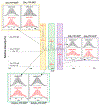Cadmium Exchange with Zinc in the Non-Classical Zinc Finger Protein Tristetraprolin
- PMID: 33999622
- PMCID: PMC8501473
- DOI: 10.1021/acs.inorgchem.0c03808
Cadmium Exchange with Zinc in the Non-Classical Zinc Finger Protein Tristetraprolin
Abstract
Tristetraprolin (TTP) is a nonclassical CCCH zinc finger protein that regulates inflammation. TTP targets AU-rich RNA sequences of cytokine mRNAs forming a TTP/mRNA complex. This complex is then degraded, switching off the inflammatory response. Cadmium, a known carcinogen, triggers proinflammatory effects, and there is evidence that Cd increases TTP expression in cells, suggesting that Zn-TTP may be a target for cadmium toxicity. We sought to determine whether Cd exchanges with Zn in the TTP active site and measure the effect of RNA binding on this exchange. A construct of TTP that contains the two CCCH domains (TTP-2D) was employed to investigate these interactions. A spin-filter ICP-MS experiment to quantify the metal that is bound to the ZF after metal exchange was performed, and it was determined that Cd exchanges with Zn in Zn2-TTP-2D and that Zn exchanges with Cd in Cd2-TTP-2D. A native ESI-MS experiment to identify the metal-ZF complexes formed after metal exchange was performed, and M-TTP-2D complexes with singular and double metal exchange were observed. Metal exchange was measured in both the absence and presence of TTP's partner RNA, with retention of RNA binding. These data show that Cd can exchange with Zn in TTP without affecting function.
Conflict of interest statement
The authors declare no competing financial interest.
Figures







Similar articles
-
Pb(II) coordination to the nonclassical zinc finger tristetraprolin: retained function with an altered fold.J Biol Inorg Chem. 2023 Feb;28(1):85-100. doi: 10.1007/s00775-022-01980-1. Epub 2022 Dec 7. J Biol Inorg Chem. 2023. PMID: 36478265
-
Cu(I) Disrupts the Structure and Function of the Nonclassical Zinc Finger Protein Tristetraprolin (TTP).Inorg Chem. 2017 Jun 19;56(12):6838-6848. doi: 10.1021/acs.inorgchem.7b00125. Epub 2017 May 30. Inorg Chem. 2017. PMID: 28557421 Free PMC article.
-
Cadmium coordination to the zinc binding domains of the non-classical zinc finger protein Tristetraprolin affects RNA binding selectivity.J Inorg Biochem. 2012 Jul;112:32-8. doi: 10.1016/j.jinorgbio.2012.02.023. Epub 2012 Mar 16. J Inorg Biochem. 2012. PMID: 22542594
-
Tristetraprolin (TTP): interactions with mRNA and proteins, and current thoughts on mechanisms of action.Biochim Biophys Acta. 2013 Jun-Jul;1829(6-7):666-79. doi: 10.1016/j.bbagrm.2013.02.003. Epub 2013 Feb 18. Biochim Biophys Acta. 2013. PMID: 23428348 Free PMC article. Review.
-
The tandem zinc finger RNA binding domain of members of the tristetraprolin protein family.Wiley Interdiscip Rev RNA. 2019 Jul;10(4):e1531. doi: 10.1002/wrna.1531. Epub 2019 Mar 12. Wiley Interdiscip Rev RNA. 2019. PMID: 30864256 Free PMC article. Review.
Cited by
-
Pb(II) coordination to the nonclassical zinc finger tristetraprolin: retained function with an altered fold.J Biol Inorg Chem. 2023 Feb;28(1):85-100. doi: 10.1007/s00775-022-01980-1. Epub 2022 Dec 7. J Biol Inorg Chem. 2023. PMID: 36478265
-
Is Cadmium Genotoxicity Due to the Induction of Redox Stress and Inflammation? A Systematic Review.Antioxidants (Basel). 2024 Aug 1;13(8):932. doi: 10.3390/antiox13080932. Antioxidants (Basel). 2024. PMID: 39199178 Free PMC article. Review.
-
The past, present, and future of artificial zinc finger proteins: design strategies and chemical and biological applications.J Biol Inorg Chem. 2023 Apr;28(3):249-261. doi: 10.1007/s00775-023-01991-6. Epub 2023 Feb 7. J Biol Inorg Chem. 2023. PMID: 36749405 Free PMC article.
-
Zinc in Cognitive Impairment and Aging.Biomolecules. 2022 Jul 18;12(7):1000. doi: 10.3390/biom12071000. Biomolecules. 2022. PMID: 35883555 Free PMC article. Review.
-
C(P)XCG Proteins of Haloferax volcanii with Predicted Zinc Finger Domains: The Majority Bind Zinc, but Several Do Not.Int J Mol Sci. 2024 Jun 28;25(13):7166. doi: 10.3390/ijms25137166. Int J Mol Sci. 2024. PMID: 39000272 Free PMC article.
References
-
- Laity JH; Lee BM; Wright PE Zinc finger proteins: new insights into structural and functional diversity. Curr. Opin. Struct. Biol 2001, 11 (1), 39–46. - PubMed
-
- Lee SJ; Michel SL Structural metal sites in nonclassical zinc finger proteins involved in transcriptional and translational regulation. Acc. Chem. Res 2014, 47 (8), 2643–2650. - PubMed
-
- Michalek JL; Besold AN; Michel SL Cysteine and histidine shuffling: mixing and matching cysteine and histidine residues in zinc finger proteins to afford different folds and function. Dalton Trans. 2011, 40 (47), 12619–32. - PubMed
-
- Blackshear P Tristetraprolin and other CCCH tandem zinc-finger proteins in the regulation of mRNA turnover. Biochem. Soc. Trans 2002, 30, 945–52. - PubMed
-
- Andreini C; Banci L; Bertini I; Rosato A Counting the zincproteins encoded in the human genome. J. Proteome Res 2006, 5 (1), 196–201. - PubMed
MeSH terms
Substances
Grants and funding
LinkOut - more resources
Full Text Sources
Other Literature Sources

